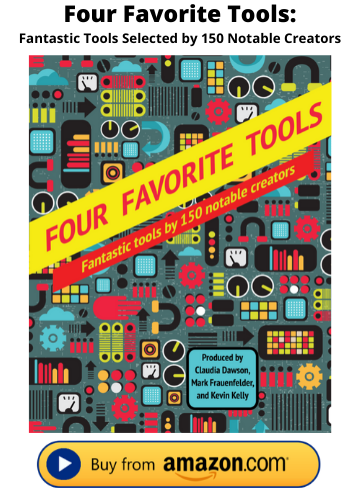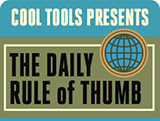A cool tool can be any book, gadget, software, video, map, hardware, material, or website that is tried and true. All reviews on this site are written by readers who have actually used the tool and others like it. Items can be either old or new as long as they are wonderful. We post things we like and ignore the rest. Suggestions for tools much better than what is recommended here are always wanted.
Tell us what you love.Categories
- Announcements
- Aural
- Autonomous Motion
- Backpacking
- Big Systems
- Clothing
- Communications
- Community
- Computers
- Consumptivity
- Craft
- Culture
- Dead Tools
- Deals
- Design
- Destinations
- Dwelling
- Edibles
- Every Day Carry
- Family
- Gardens
- Gareth's Tips
- General Purpose Tools
- Health
- Homestead
- Inner Space
- Just 1 Question
- Kitchen
- Learning
- Life on Earth
- Livelihood
- Living on the Road
- Maker Tools
- Maker Update
- Materials
- Media Tools
- Multiple Product Reviews
- No Stream
- Nomadico
- Paper World
- Photography
- Play
- Podcast
- Prove Us Wrong
- Readers' Gifts
- Recomendo
- Related Stuff
- Science Method
- Somatics
- Source Wanted
- Tips
- Tool Chest
- Tools for Possibilities
- Uncategorized
- Vehicles
- Videos
- Visual Media
- What's in My Bag
- Workplace
- Workshop
Check for Year-end Credit Card Perks
While some travel credit card perks renew whenever your annual fee comes due, such as United card lounge passes or the IHG card’s free night’s stay, others are on a calendar year. I just saved $150 on 2026 hotel stays by tapping a $50 credit on the Chase Sapphire Preferred card and a $100 one on my Delta Amex one that would have expired 12/31. Keep this in mind when applying for a new card too: if you obtain it with enough time on the calendar, you could benefit twice in less than a year.
Earbuds That Don’t Go in Your Ear
My wife has tinnitus that probably dates back to our music biz days in New York and earbuds that go into your ears make it worse for many people with that condition. Headphones are usually better but are bulky. She recently found a solution in Shokz earbuds that sit outside the ear and conduct sound through the bones of your skull. These don’t block noise, which could be a downside on a plane, but that’s a plus for runners and bicyclists who want to stay aware of their surroundings. Here are links to the two-piece over-ear ones that go in a recharge case and the single unit that fits over the head like normal headphones.
England’s Expensive Airport Drop-offs
“Can you take me to the airport?” might be a question that requires you to pull out your wallet if you’re in England. I had no idea airport drop-off fees were even a thing until I saw this story about them increasing to £10 ($13.40) at the London Gatwick airport. Apparently you also have to pay £7 to drop someone off at Heathrow. This hikes up the price of any taxi or Uber charge as well. Apparently they really want you to #takethetrain.
A Different Kind of Travel Wallet
I usually use a bulkier wallet at home than I do when I travel and I like this new Forge Wallet I’ve been using lately. It’s about the thickness of a normal wallet but much narrower, with a compartment where you press down on a button and your credit cards pop out, staggered so you can see which one is which. It’s RFID blocking and there’s an optional little steel multi-tool card that fits inside a dedicated pocket. See my quickie Instagram reel on it here.
A weekly newsletter with four quick bites, edited by Tim Leffel, author of A Better Life for Half the Price and The World’s Cheapest Destinations. See past editions here, where your like-minded friends can subscribe and join you.










